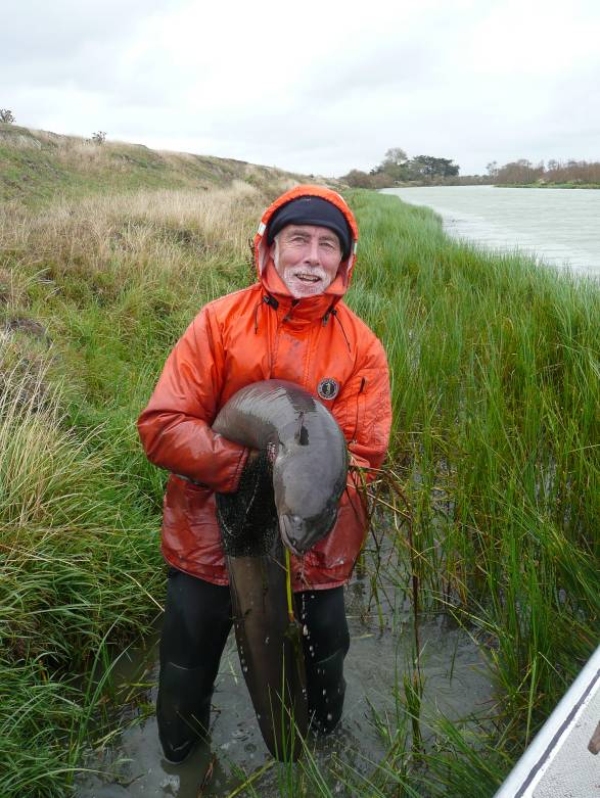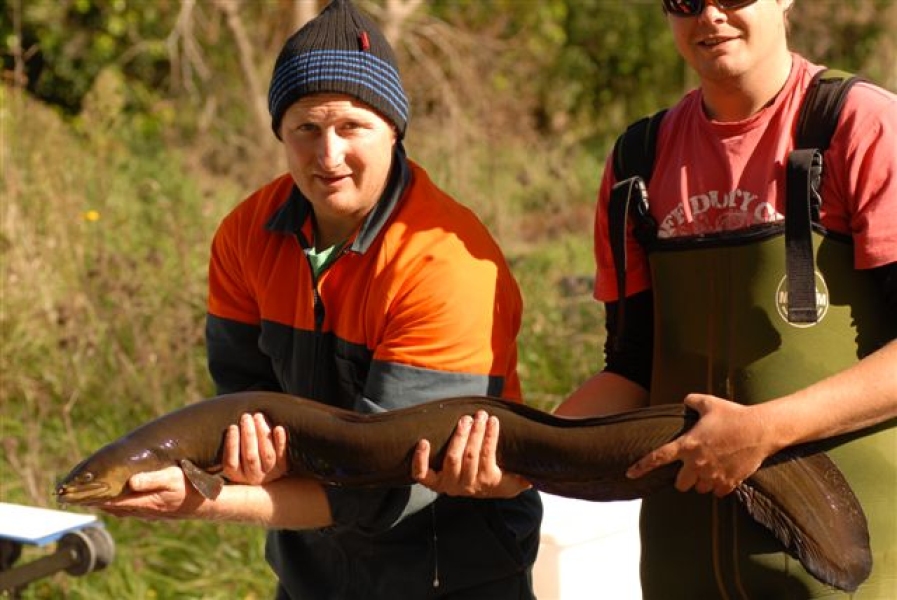New Zealand longfins are one of the largest eel species in the world, and have been recorded at sizes of almost 2 m in length and more than 50 kg in weight.
Only two other freshwater eel species approach this size: the Australian longfin eel (up to 1.6 m and 22 kg) and the Chinese spotted eel (A. marmorata) (up to 2 m and 28 kg). Shortfin eels do not grow as large as longfins.
Eel growth rates are highly variable due to species, sex, location, water temperature, season (growth slows in winter), population density, food supply and the types of habitats. Female eels grow larger and are older than males of the same species at maturity. Growth rates may also vary with age.
Typically, the growth rates of both species are slow, averaging about 2 to 5 cm per year. However, given favourable circumstances, growth can be very rapid and eels grown in culture conditions can grow to 40 cm (about 200 g) within one year. In the wild, eels of this size would generally be 10 to 15 years old.
High growth rates may occur where food is abundant and/or where there are low numbers of eels (e.g. 41 mm per year, recorded for eel transplanted into virgin habitats) but can be very poor in highly modified habitats with high recruitment.
Researchers have found larger and faster growing eels in pasture settings compared to native and exotic forest, and settings dominated by willow or tussock. Pasture sites are likely to be associated with higher nutrient levels, increased light, and therefore increased productivity which could explain the larger size of eels. The lower water temperatures associated with forested areas in comparison to more open pastoral areas may also partially explain lower eel growth.
References and further reading
Beentjes, M.P., Jellyman, D.J. (2003). Enhanced growth of longfinned eels, Anguilla dieffenbachii, transplanted into Lake Hawea, a high country lake in South Island, New Zealand. New Zealand Journal of Marine and Freshwater Research 37: 1-11. http://www.tandfonline.com/doi/pdf/10.1080/00288330.2003.9517141
Burnet, A.M.R. (1968). The growth of New Zealand freshwater eels in three Canterbury streams. New Zealand Journal of Marine and Freshwater Research 3: 376-384. http://www.royalsociety.org.nz/publications/journals/nzjm/1969/033/
Burnett, A.M.R. (1968). Migrating eels in a Canterbury river, New Zealand. New Zealand Journal of Marine and Freshwater Research 3: 230-244. http://www.royalsociety.org.nz/publications/journals/nzjm/1969/021/
Chisnall, B.L. (1989). Age, growth, and condition of freshwater eels (Anguilla spp.) in backwaters of the lower Waikato River, New Zealand. New Zealand Journal of Marine and Freshwater Research 23: 459-465. http://www.royalsociety.org.nz/publications/journals/nzjm/1989/049/
Chisnall, B.L., Hicks, B.J. (1993). Age and growth of longfinned eels (Anguilla dieffenbachii) in pastoral and forested streams in the Waikato River basin, and in two hydro-electric lakes in the North Island, New Zealand. New Zealand Journal of Marine and Freshwater Research 27: 317-332. http://www.royalsociety.org.nz/publications/journals/nzjm/1993/030/
Domingos, I., Costa, J.L., Costa, M.J. (2006). Factors determining length distribution and abundance of the European eel, Anguilla anguilla, in the River Mondego (Portugal). Freshwater Biology 51: 2265-2281. http://onlinelibrary.wiley.com/doi/10.1111/j.1365-2427.2006.01656.x/abstract
Graham, D.H. (1956). A Treasury of New Zealand Fishes. Reed, Wellington. 424 p.
Graynoth, E., Taylor, M.J. (2000). Influence of different rations and water temperatures on the growth rates of shortfinned eels and longfinned eels. Journal of Fish Biology 57(3): 681-699. http://onlinelibrary.wiley.com/doi/10.1111/j.1095-8649.2000.tb00268.x/abstract
Hicks, B.J., McCaughan, H.M.C. (1997). Distribution of fish and crayfish, and eel production, in streams in forest and pasture in the Waikato Region, New Zealand. New Zealand Journal of Marine and Freshwater Research 31(5): 635-650. http://www.tandfonline.com/doi/abs/10.1080/00288330.1997.9516795
Jellyman, D.J. (1997). Variability in growth rates of freshwater eels (Anguilla spp.) in New Zealand. Ecology of Freshwater Fish 6: 108–115. http://onlinelibrary.wiley.com/doi/10.1111/j.1600-0633.1997.tb00151.x/pdf
Potts, T.H. (1882). Out in the open: a budget of scraps of natural history gathered in New Zealand. Christchurch, Littleton Times. 301 p.
Tesch, F.W. (2003). The Eel. Fifth edition. Blackwell Science Ltd and The Fisheries Society of the British Isles, Oxford. 408 p.


